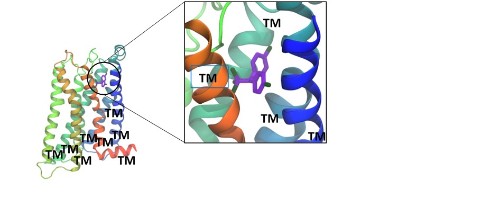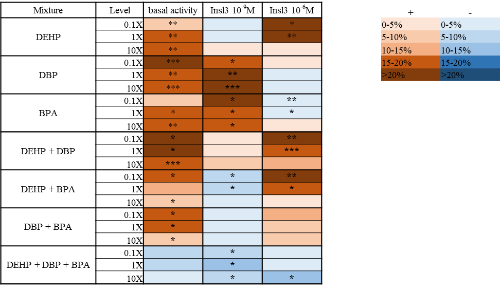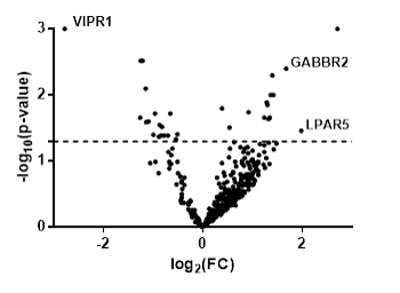- >Discover our teams
- >CarMe
- >G protein coupled Receptors in Endocrinology and Metabolism: from molecular mechanisms to pathophysiology
G protein coupled Receptors in Endocrinology and Metabolism: from molecular mechanisms to pathophysiology

Patrice Rodien, MD,PhD

PaRodien@chu-angers.fr
Keywords: GPCR signalling, endocrine disruptors, endocrine-related cancers.
People involved
Mathilde Munier, Researcher Ph.D., CHU Angers
Régis Coutant, PU-PH, M.D., CHU Angers
Claire Briet, MCU-PH, M.D, Ph.D., CHU Angers
Valentine Suteau, M.D, Ph.D, CHU Angers
Louis Gourdin, Technician, CHU Angers
Julien Robin, AHU
Lucie Levaillant, Ph.D. Student
More than 800 human membrane G-protein-coupled receptors (GPCRs) are signal transducers. They are activated by a wide variety of ligands such as hormone and metabolites and are able to activate different intracellular signalling pathways. GPCRs are key players in endocrine and metabolism regulations.
Our objective is to better understand the regulation of several key endocrine GPCR signalling in patho-physiological conditions. Our projects are mainly focused on the impact of environmental compounds on GPCR signalling (Axis I), on the influence of GPCR signalling in endocrine neoplasia (Axis II) and on the functional characterisation of endocrine GPCR mutations (Axis III).
Axis I - The impact of environmental compounds on GPCR signalling
In order to better understand the activation mechanisms of GPCRs and more particularly to identify which molecules could activate or inhibit them, we are interested in the effect of small molecules present in the environment on the signalling of GPCRs. Of note, these compounds also called endocrine disrupting chemicals (EDC) have a negative impact on endocrine and metabolism system. We have shown that the pesticide DDT binds to the transmembrane part of the FSH (follicle stimulating hormone) receptor and thus potentiates its action (Munier et al, 2016). We have also demonstrated that bisphenol A (BPA), which has a structure similar to DDT, decreases the activity of the FSH receptor. BPA is one of the most widely produced chemical compounds in the world. Thanks to its polymerization properties, it is used in polycarbonate plastics and epoxy resins, as well as in cash tickets or dental fillings. Thus, BPA appears to be a negative allosteric modulator of the FSH receptor.

3D representation of the mode of DDT binding in the transmembrane domain of the FSH receptor.
In addition, we have confirmed the effects of these environmental compounds on the activity of hormonal GPCRs by showing that a mixture of BPA and phthalates, with concentrations found in human amniotic fluid, modulates the activity of the INSL3 receptor: RXFP2 (Suteau et al, 2020).

Heat-map of individual and combined effects of BPA and phthalates on INSL3/RXFP2 signalling.
Our research thus provides new fundamental data allowing a better understanding of the role of GPCR in the pathophysiology of environmental compounds. The finding of our work will allow the future investigation of the role of EDCs on GPCRs in the area of energy homeostasis.
Axe II – The influence of GPCR signalling in endocrine neoplasia
Endocrine neoplasia include neuroendocrine tumours, paraganglioma, pheochromocytoma, adrenal carcinoma, ovary, testes, parathyroid, pituitary and thyroid tumors. For the last years, it was shown that GPCRs play an important role not only in mediating physiological function but also in controlling initiation and progression of different tumour types. Moreover, GPCRs are the most prominent family of validated pharmacological targets and their targeting has already given interesting results in some cancers. However, their role and their targeting in endocrine neoplasia was not precisely studied. Given these data, we hypothesize that pharmacological targeting of GPCRs in association with gold standard treatment could be an interesting therapeutic approach in endocrine-related cancers to synergize treatments.
Because of its high frequency, we are primarily focusing on thyroid cancer. As a first step, we established an atlas of GPCRs expression in thyroid cancer to identify GPCRs differentially expressed between normal and tumoral thyroid tissues to select potential targets. Second, we are developing a quantitative high throughput drug screening in cell lines and primary cultures of thyroid cancer to identify synergistic combinatorial drug therapy. We are also transposing this model to other endocrine tumours. Using bioinformatics analyses, we are now identifying some GPCR as potential therapeutic target.

Volcano plot of differentially expressed GPCRs gene between thyroid cancer and normal tissues from 17 patients with refractory thyroid cancer.
Axis III – The functional characterisation of endocrine GPCR mutations
The team is also attached to the Reference Center for Rare Thyroid Diseases and Hormonal Receptors (coordinated by Pr P. Rodien) and the Reference Center for Rare Pituitary Diseases (coordinated by Pr R. Coutant). This center, created in 2006, joined the FIRENDO endocrine rare diseases network in 2017 and the European ENDO ERN. In this context, the team participates to the characterization of patient mutations of hormone receptors (Coulon et al, 2016).
Main publications
- G Protein-Coupled Receptors in radioiodine-refractory thyroid cancer in the Era of Precision Medicine - Suteau V, Seegers V, Munier M, Ben Boubaker R, Croue A, Illouz F, Hamy A, Rodien P, Briet C - J Clin Endocrinol Metab. 2021 May 17:dgab343. doi: 10.1210/clinem/dgab343.
- In vitro efects of the endocrine disruptor p,p′DDT on human choriogonadotropin/luteinizing hormone receptor signalling. Mathilde Munier1,· Mohammed Ayoub, · Valentine Suteau, · Louis Gourdin,· Daniel Henrion, Eric Reiter,· Patrice Rodien. Arch Toxicol (2021). https://doi.org/10.1007/s00204-021-03007-1.
- Human amniotic fluid-based exposure levels of phthalates and bisphenol A mixture reduce INSL3/RXFP2 signaling. Suteau V, Briet C, Lebeault M, Gourdin L, Henrion D, Rodien P, Munier M. Environ Int. 2020 May;138:105585.
- In Vitro Effects of the Endocrine Disruptor p,p'-DDT on Human Follitropin Receptor. Munier M, Grouleff J, Gourdin L, Fauchard M, Chantreau V, Henrion D, Coutant R, Schiøtt B, Chabbert M, Rodien P. Environ Health Perspect. 2016 Jul;124(7):991-9.
Funding from the 5 last years
- Prix de recherche en Endocrinologie, Laboratoire Pfizer, 2020 (Dr V. Suteau)
- Bourse de master de la Société Française d'Endocrinologie et Diabétologie Pédiatrique (2020)
- Bourse de thèse Plan Cancer/AVIESAN/INSERM (2019)
- Appel d’offre interne, CHU d’Angers, 2018 (Dr C. Briet)
- Bourses de master recherche de la Société Française d'Endocrinologie (2016,2017)
Partners
- Reference center for rare diseases Thyroid and Hormonal Receptors
- Reference center for rare diseases of pituitary gland
- Department of Endocrinology, Diabetes and Nutrition of the CHU d'Angers
- Department of Pediatric Endocricinology of the CHU d’Angers
- Association Recherche en Endocrinologie et Développement de l'Adulte et de l'Enfant
Main collaborations
- Center for Insoluble Protein Structures and Department of Chemistry, Aarhus University (Dr B. Schiott)
- Department of Biology, College of Science, United Arab Emirates University (Dr MA. Ayoub)
- Reproductive and Behavioral Physiology, INRAE, CNRS, IFCE, Tours University (Dr E.Reiter)
- Curie Institute Research Center, Paris, France
- Institut de Cancérologie de l’Ouest, Angers, France (Dr V. Seegers)
- Departement of Pharmocoly-Toxicology, Angers Hospital, France (Pr M. Briet)


